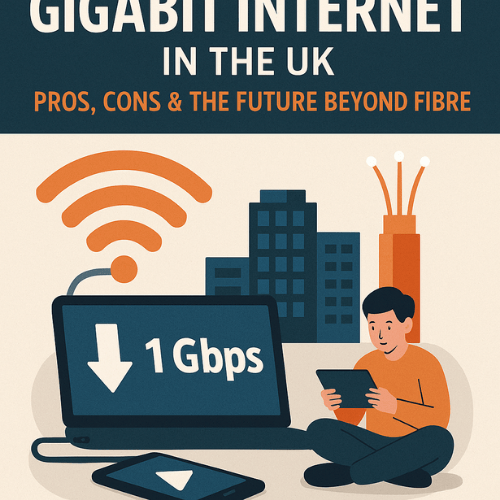Gigabit Internet UK 2025: Pros, Cons & the Future Beyond Fibre

“Gigabit internet.” Sounds flashy, right? Providers market it like the holy grail of broadband: speeds so fast you’ll never buffer again, downloads that finish before you’ve made a coffee, and streaming that feels instant.
And in 2025, the UK is closer than ever. With 86% gigabit-capable coverage (thanks to fibre rollouts and Virgin Media’s upgrades), millions of households now have the option to go gigabit. But here’s the kicker: do you actually need it? And what are the downsides nobody talks about?
When you Google questions like:
- What are the disadvantages of gigabit internet?
- Will 6G replace fibre?
- Who’s the biggest fibre provider in the UK?
…you’ll find half-answers, jargon, or sales pitches. That’s why we created this guide.
In the next few minutes, we’ll break down what gigabit internet really means, who benefits, where it falls short, and what’s next (yes, including whether 6G is waiting in the wings). We’ll use the latest data, cut through the hype, and keep it real.
Because gigabit internet isn’t just a headline speed. It’s a decision about how you work, stream, game, and connect, and whether you’re paying for more than you actually use.
What Is Gigabit Internet? (Explained Simply)
At its core, gigabit internet means speeds of up to 1,000 Mbps (1 Gbps). That’s 10x faster than the average UK broadband connection in 2020, and powerful enough to handle entire households streaming, gaming, working, and running smart devices at the same time.
To put it in real-world terms:
- Download a full HD movie in under 40 seconds.
- Upload massive files to the cloud almost instantly.
- Game online with near-zero lag.
- Run dozens of smart home devices without slowdown.
But here’s where people get confused: gigabit doesn’t always mean fibre. In the UK, “gigabit-capable” can mean:
- Full fibre (FTTP): the gold standard, fastest, most reliable.
- Hybrid fibre/coax (Virgin Media): fast, but not future-proof.
- 5G home broadband: great for flexibility, but speed and stability vary.
If your speeds are crawling, it doesn’t always mean you need a gigabit; sometimes, your setup is the bottleneck. Our Boost Broadband Speed Guide covers quick fixes like router placement, cabling, and Wi-Fi optimisation before you upgrade.
Bottom line: Gigabit is less about “never buffering again” and more about future-proofing your connection. For some households, it’s a must-have. For others, it’s overkill. The key is knowing whether you’ll actually use it.
What Are the Disadvantages of Gigabit Internet?
Gigabit internet sounds unbeatable, but here’s the truth: it’s not always worth it.
Cost vs. Real-World Need
Gigabit plans usually carry a premium price tag. But most households don’t need 1,000 Mbps. Streaming Netflix in 4K only requires about 25 Mbps, and video calls use less than 5 Mbps. Unless you’ve got a large household with gamers, streamers, and heavy remote workers all online at once, you may be paying for speed you’ll never touch.
Hardware Bottlenecks
Even if you sign up for gigabit, your devices may not be able to use it. Old laptops, budget smartphones, or outdated Wi-Fi routers max out far below 1 Gbps. That means you could be paying for performance your home setup can’t deliver.
Network Management & Throttling
Some providers still manage traffic during peak hours. That means even gigabit customers can see slower speeds at night. If you’ve ever wondered why your internet lags when everyone’s online, check our guide on Broadband Throttling in the UK.
Diminishing Returns
Beyond a certain point, you won’t notice the difference. Jumping from 30 Mbps to 150 Mbps feels huge. Jumping from 300 Mbps to 1,000 Mbps? For most users, it is barely noticeable.
Bottom line: Gigabit broadband isn’t a scam, it’s the future. But right now, it’s often overkill for the average home. Unless your household is ultra-connected, a solid mid-tier fibre plan could save you money without sacrificing performance.
Will 6G Replace Fibre?
There’s a lot of hype around 6G, the next generation of mobile networks expected to arrive in the early 2030s. With promises of ultra-low latency and speeds beyond 1 Tbps in lab tests, it’s no wonder people ask: will 6G make fibre obsolete?
The short answer: no.
Wireless tech like 5G, and eventually 6G, will be powerful, but it still relies on fibre backbones to deliver stability. Think of fibre as the “motorway” and wireless as the “slip roads.” Without fibre in the ground, mobile networks can’t deliver those next-gen speeds at scale.
Here’s why fibre isn’t going anywhere:
- Reliability: Wireless can fluctuate with weather, distance, or congestion. Fibre stays consistent.
- Capacity: Fibre can handle terabits of data without breaking a sweat. Wireless will always be limited by spectrum.
- Latency: Gamers, traders, and telehealth services need ultra-stable latency. Fibre is unmatched.
For context, we’ve already seen this debate with 5G. Our guide on The Future of 5G Networks explains how 5G didn’t kill fibre, it complemented it. The same will happen with 6G.
Bottom line: 6G won’t replace fibre; it will depend on it. Fibre is the foundation, wireless is the extension. The two together are what will power the UK’s digital future.
Who Is the Largest Fibre Provider in the UK?
When it comes to full fibre in the UK, BT Openreach is the undisputed giant.
As of 2025, Openreach’s network passes more than 17 million premises, with a target of 25 million by 2026. That makes it the largest full-fibre infrastructure provider in the country. And because Openreach is a wholesale network, its fibre underpins dozens of household names, from BT and Sky to TalkTalk and Plusnet.
Want to see what’s available? Check our BT Broadband provider page for the latest plans.
Virgin Media O2: The Challenger
Virgin Media O2 is the biggest alternative, with over 15 million premises connected to its gigabit-capable network. While much of this is still hybrid fibre-coax, Virgin has started expanding into true FTTP (fibre-to-the-premises). You can compare their offers on our Virgin Media Broadband page.
Alt-Nets on the Rise
Meanwhile, smaller “alt-nets” like CityFibre, Hyperoptic, and Community Fibre are aggressively building out. CityFibre aims for 8 million homes by 2026, while Hyperoptic dominates in apartment blocks. In some postcodes, these niche providers actually beat Openreach and Virgin to the punch.
Bottom line: Openreach leads the UK fibre race, Virgin Media O2 is catching up, and alt-nets are shaking up local markets. Together, they’re driving the UK toward near-universal gigabit coverage by 2030.
Is Gigabit Worth It for Gamers, Streamers & Families?
So, is gigabit broadband really worth the hype? The answer depends on how your household uses the internet.
For Gamers
Online gaming thrives on low latency, not just raw speed. Gigabit connections often mean better stability and quicker updates, especially when multiple devices are active. If you’re downloading massive AAA titles, 1 Gbps slashes hours off your wait. We break this down further in our Broadband for Gamers UK guide.
For Streamers & Binge-Watchers
4K streaming uses just 15–25 Mbps per stream. That means most fibre packages already cover it. But in a big household where everyone streams at once, think Netflix, YouTube, and Disney+ on multiple TVs, gigabit ensures smooth playback without buffering wars.
Families & Remote Workers
With multiple devices running Zoom calls, online classes, cloud backups, and smart home gadgets, the demand stacks up quickly. Gigabit helps large families avoid slowdowns during peak usage. If you’re working from home full-time, the faster upload speeds of fibre gigabit can make video calls and file sharing seamless.
The Verdict
For small households, gigabit is probably overkill. But for gamers, streamers, and large families? It’s a game-changer. The key is balancing price vs. actual need, and checking if mid-tier fibre (150–300 Mbps) already does the job.
Bottom line: gigabit broadband isn’t for everyone. But if your household is ultra-connected, it can be the difference between smooth digital living and constant buffering battles.
FAQ Round-Up + Conclusion
We’ve covered what gigabit internet is, who provides it, and where it makes sense, but let’s close by tackling the questions people ask every day.
What Percentage of the UK Has Gigabit Internet in 2025?
As of 2025, around 86% of UK premises are gigabit-capable, though not all of that is full fibre. Virgin Media’s network makes up a big chunk, while Openreach and alt-nets are expanding true FTTP. Curious about fibre specifically? See our UK Full Fibre Guide.
Do I Really Need Gigabit Speeds?
Not everyone does. If your household just browses, streams, and shops online, 100–300 Mbps is usually enough. Gigabit shines for gamers, streamers, large households, and remote workers. Our Compare Broadband Deals page helps you decide what’s right for your usage.
Will 5G or 6G Replace Fibre?
No. Mobile tech is powerful, but it still depends on fibre backbones. 6G will complement fibre, not replace it. We cover this myth in our 5G Networks Future Guide.
Who Is the Largest Fibre Provider in the UK?
BT Openreach leads, powering multiple ISPs, while Virgin Media is the biggest challenger. Check the latest offers at:
Conclusion: Should You Go Gigabit?
Here’s the truth: gigabit broadband is the future of connectivity, but not everyone needs it today. If your household is heavy on gaming, streaming, or remote work, it’s a smart investment. If not, a mid-tier fibre plan may save you money without slowing you down.
>>Want to check if gigabit is live at your address? Start with Broadband Deals Near Me.
>>Ready to compare providers side by side? Head to our Broadband Comparison.
Bottom line: don’t buy into the hype blindly. Gigabit is powerful, but the smartest move is choosing the plan that fits your life, not just the fastest speed on paper.



